Fiber optik adalah sebuah kaca murni yang panjang dan tipis serta berdiameter sebesar rambut manusia. Dan dalam pengunaannya beberapa fiber optik dijadikan satu dalam sebuah tempat yang dinamakan kabel optik dan digunakan untuk mengantarkan data digital yang berupa sinar dalam jarak yang sangat jauh.
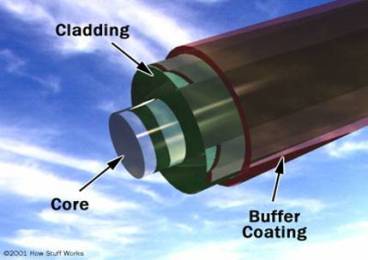 Core adalah kaca tipis yang merupakan bagian inti dari fiber optik yang dimana pengiriman sinar dilakukan.
Core adalah kaca tipis yang merupakan bagian inti dari fiber optik yang dimana pengiriman sinar dilakukan.
Cladding adalah materi yang mengelilingi inti yang berfungsi memantulkan sinar kembali ke dalam inti(core).
Buffer Coating adalah plastic pelapis yang melindungi fiber dari kerusakan.
Jenis Fiber Optik
1. Single-mode fibers
Mempunyai inti yang kecil (berdiameter 0.00035 inch atau 9 micron) dan berfungsi mengirimkan sinar laser inframerah (panjang gelombang 1300-1550 nanometer)
2. Multi-mode fibers
Mempunyai inti yang lebih besar(berdiameter 0.0025 inch atau 62.5 micron) dan berfungsi mengirimkan sinar laser inframerah (panjang gelombang 850-1300 nanometer)

Cara Kerja Fiber Optik
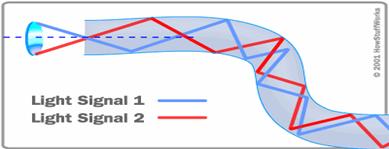
Sinar dalam fiber optik berjalan melalui inti dengan secara memantul dari cladding, dan hal ini disebut total internal reflection, karena cladding sama sekali tidak menyerap sinar dari inti. Akan tetapi dikarenakan ketidakmurnian kaca sinyal cahaya akan terdegradasi, ketahanan sinyal tergantung pada kemurnian kaca dan panjang gelombang sinyal.
Keuntungan Fiber Optik
Murah : jika dibandingkan dengan kabel tembaga dalam panjang yang sama.
Lebih tipis: mempunyai diameter yang lebih kecil daripada kabel tembaga.
Kapasitas lebih besar.
Sinyal degradasi lebih kecil.
Tidak mudah terbakar : tidak mengalirkan listrik.
Fleksibel.
Sinyal digital.
Bagaimana Fiber Optik Dibuat
Making a preform glass cylinder
Proses ini disebut modified chemical vapor deposition (MCVD).
Silikon dan germanium bereaksi dengan oksigen membentuk SiO2 dan GeO2.
SiO2 dan GeO2 menyatu dan membentuk kaca.
Proses ini dilakukan secara otomatis dan membutuhkan waktu beberapa jam.
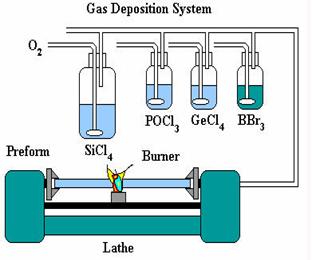
Drawing the fiber from the preform
Setelah proses pertama selesai preform dimasukkan kedalam fiber drawing tower.
Kemudian dipanaskan 1900-2200 derajat celcius sampai meleleh.
Lelehan tersebut jatuh melewati laser mikrometer sehingga preform membentuk benang.
Dilakukan proses coating dan UV Curing.
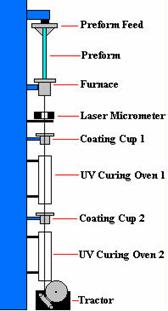
Testing the Finished Optical Fiber
Tensile strength: harus mampu menahan 100.000 lb/inch2 atau lebih.
Refractive index profile : menghitung layar untuk pemantulan optik.
Fiber geometry : diameter Core, dimensi cladding, diameter cloating adalah seragam.
Attenuation : menghitung kekuatan sinyal dari berbagai panjang gelombang dan jarak.
Information carrying capacity : bandwith
Chromatic dispersion : penyebaran berbagai panjang gelombang sinar melalui core.
Operating temperature
Kabel Optik Yang Sering Digunakan
Distribution Cable
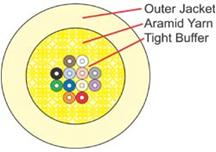
Indoor/Outdoor Tight Buffer

Indoor/Outdoor Breakout Cable

Aerial Cable/Self-Supporting
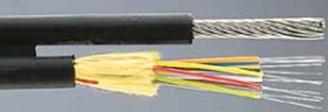
Hybrid & Composite Cable

Armored Cable
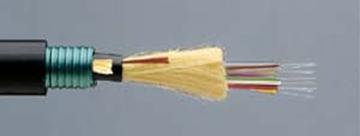
Low Smoke Zero Halogen (LSZH)
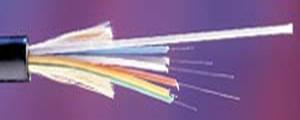
Bagian-bagian fiber optik

Cladding adalah materi yang mengelilingi inti yang berfungsi memantulkan sinar kembali ke dalam inti(core).
Buffer Coating adalah plastic pelapis yang melindungi fiber dari kerusakan.
Jenis Fiber Optik
1. Single-mode fibers
Mempunyai inti yang kecil (berdiameter 0.00035 inch atau 9 micron) dan berfungsi mengirimkan sinar laser inframerah (panjang gelombang 1300-1550 nanometer)

2. Multi-mode fibers
Mempunyai inti yang lebih besar(berdiameter 0.0025 inch atau 62.5 micron) dan berfungsi mengirimkan sinar laser inframerah (panjang gelombang 850-1300 nanometer)

Cara Kerja Fiber Optik

Sinar dalam fiber optik berjalan melalui inti dengan secara memantul dari cladding, dan hal ini disebut total internal reflection, karena cladding sama sekali tidak menyerap sinar dari inti. Akan tetapi dikarenakan ketidakmurnian kaca sinyal cahaya akan terdegradasi, ketahanan sinyal tergantung pada kemurnian kaca dan panjang gelombang sinyal.
Keuntungan Fiber Optik
Murah : jika dibandingkan dengan kabel tembaga dalam panjang yang sama.
Lebih tipis: mempunyai diameter yang lebih kecil daripada kabel tembaga.
Kapasitas lebih besar.
Sinyal degradasi lebih kecil.
Tidak mudah terbakar : tidak mengalirkan listrik.
Fleksibel.
Sinyal digital.
Bagaimana Fiber Optik Dibuat
Making a preform glass cylinder
Proses ini disebut modified chemical vapor deposition (MCVD).
Silikon dan germanium bereaksi dengan oksigen membentuk SiO2 dan GeO2.
SiO2 dan GeO2 menyatu dan membentuk kaca.
Proses ini dilakukan secara otomatis dan membutuhkan waktu beberapa jam.

Drawing the fiber from the preform
Setelah proses pertama selesai preform dimasukkan kedalam fiber drawing tower.
Kemudian dipanaskan 1900-2200 derajat celcius sampai meleleh.
Lelehan tersebut jatuh melewati laser mikrometer sehingga preform membentuk benang.
Dilakukan proses coating dan UV Curing.

Testing the Finished Optical Fiber
Tensile strength: harus mampu menahan 100.000 lb/inch2 atau lebih.
Refractive index profile : menghitung layar untuk pemantulan optik.
Fiber geometry : diameter Core, dimensi cladding, diameter cloating adalah seragam.
Attenuation : menghitung kekuatan sinyal dari berbagai panjang gelombang dan jarak.
Information carrying capacity : bandwith
Chromatic dispersion : penyebaran berbagai panjang gelombang sinar melalui core.
Operating temperature
Kabel Optik Yang Sering Digunakan
Distribution Cable

Indoor/Outdoor Tight Buffer

Indoor/Outdoor Breakout Cable

Aerial Cable/Self-Supporting

Hybrid & Composite Cable

Armored Cable

Low Smoke Zero Halogen (LSZH)
